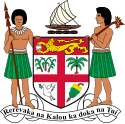1987 Fijian coups d'état
| 1987 Fijian coups d'état | |||||||
|---|---|---|---|---|---|---|---|
| Part of the Fijian coups | |||||||
| |||||||
| Belligerents | |||||||
|
Fijian Armed Forces |
Government of Fiji | ||||||
| Commanders and leaders | |||||||
|
| |||||||
 |
|---|
| ||
|---|---|---|
|
1992 – 1999, 2022 – present
2018 – 2022
Timeline
General elections
|
||
| History of Fiji |
|---|
 |
| Early history |
| Modern history |
| Coup of 2000 |
| Proposed Reconciliation Commission |
|
| Crisis of 2005–2006 |
| Coup of 2006 |
| Part of the Politics series |
| Republicanism |
|---|
|
|
The Fijian coups d'état of 1987 resulted in the overthrow of the elected government of Fijian Prime Minister
Background
Both before and after Fiji gained its independence from the
Coups d'etat
May coup
On the morning of 14 May, around 10 am, a section of ten masked, armed soldiers entered the Fijian
At around 11 am,
Following the coup, the Governor-General commissioned a Constitution Review Committee, led by Sir John Falvey, to look at the "deficiencies" of Fiji's 1970 constitution.
The commission was to begin hearings on 6 July and deliver its recommendations to the Governor-General by 31 July. Its terms of reference were to "strengthen the representation of indigenous
The Governor-General dissolved Parliament and granted amnesty to Rabuka, while promoting him to the position of commander of the Royal Fiji Military Forces. The actions of the Governor-General were viewed with suspicion by the deposed government and Bavadra challenged Ratu Sir Penaia's decision in the Supreme Court of Fiji.[8]
September coup
From independence in 1970, Fiji's
International involvement
Australia and New Zealand, the two nations with foremost political influence in the region, were somewhat disquieted by the event, but ultimately took no action to intervene. They did, however, establish a policy of non-recognition regarding the new government, suspending foreign aid in concert with the United States and the United Kingdom.
The Australian labour movement, taking the ousting of a labour led government as an affront to the worldwide labour movement, instituted an embargo against shipments to Fiji. As Australia was Fiji's largest foreign trading partner, this resulted in a large diminution in Fiji's international trade.
Aftermath
In the immediate aftermath of the second coup, the United Nations denounced the coup, demanding that the former government be restored. The Commonwealth responded with Fiji's immediate expulsion from the association.
Fiji's economy contracted by as much as 7.8% between 1987 and 1988,[11] due to a major downturn in tourism and sugar production.[12]
A new constitution was ratified in 1990, in which the offices of
The coups triggered much emigration by Indo-Fijians (particularly skilled workers),[13] making them a minority by 1994.
References
- ^ Knapman 1990, p. 60.
- ^ Knapman 1990, p. 75.
- ^ Lal 2010, p. 350.
- ^ Lal 2010, p. 369.
- ^ Lal 2010, p. 390.
- ISBN 9781601270559. Retrieved 29 September 2015.
- ^ "The 1990 Constitution" (PDF). Fiji Leaks. Retrieved 29 September 2015.
- ^ Lal 2010, p. 407.
- ^ a b "Fiji coup leader declares republic". The New York Times. 7 October 1987. Retrieved 15 May 2019.
- ^ a b "Fiji Politics 1987 Coup - 14 May". Global Security. Retrieved 15 May 2019.
- ^ Knapman 1990, p. 62.
- ^ Knapman 1990, p. 64.
- ^ Knapman 1990, p. 74.
Further reading
- Elek, Andrew L.; Hill, Hal; Tabor, Steven R. (May 1993), "Liberalization and Diversification in a Small Island Economy: Fiji Since the 1987 Coups", World Development, 21 (5): 749–769, OCLC 28399361.
- OCLC 47179422
- Lal, Brij V. (2010), In the Eye of the Storm Jai Ram Reddy and the Politics of Postcolonial Fiji (PDF), ISBN 9781921666520
- Lal, Brij V.; Fortune, Kate, eds. (2000), The Pacific Islands: an encyclopedia, OCLC 41445845.
- Scobell, Andrew (January 1994), "Politics, Professionalism, and Peacekeeping: An Analysis of the 1987 Military Coup in Fiji", Comparative Politics, 26 (2), PhD Program in Political Science of the City University of New York: 187–201, JSTOR 422267.
- Knapman, Bruce (1990). "Economy and State in Fiji before and after the Coups". The Contemporary Pacific. 2 (1): 59–86. JSTOR 23701518.
External links
- Colour, Class, and Custom: The Literature of the 1987 Fiji Coup (online version of the book of the same name, ISBN 0-7315-1474-2)
- 1990 Constitution of the Republic of Fiji

